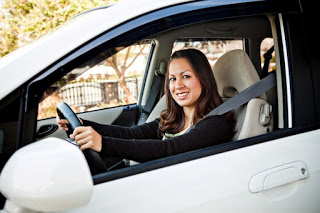Tag Archive: behind the wheel

Commit to Being a Safer Driver
April 10, 2012
Many people will make a commitment to losing weight, to do better in school, get out of debt, or join a fitness club. The sad part of making these resolutions is they are often very hard to keep and people often fail within the first few weeks or months of trying. One resolution that is easy to keep is to become a safer driver. It’s easy to achieve because licensed teenage drivers are in their vehicles every day giving them the opportunity to practice safe driving habits.
In today’s world of driving, drivers are trying to multitask behind the wheel with negative results. According to the Boston Focus Group Study of Bad Drivers:
- 77% of drivers admit to talking or texting while driving
- 60% admit to eating while driving
- 50% admit to making obscene or rude gestures or comments to other drivers, particularly those who cut in front of them
- 50% admit to almost falling asleep while behind the wheel
- Countless teens are getting behind the wheel of their vehicle drunk, high or buzzed.
Making a commitment to eliminate those types of activities from your daily driving habits isn’t hard to do. Let’s look at a few more:
- Ditch the cell phone because using a cell phone or texting while driving can be as dangerous or deadly as drunk driving. One way of doing this is to keep your cell phone far enough away that you will not be tempted to use it. Keep it turned off and let all messages go to voicemail. You can also purchase a cell phone blocker to block calls and/or texts while the vehicle is in motion. Only use a cell phone when driving for emergencies.
- Drive within the posted speed limit. When you speed you are increasing your chances of getting into a crash, injuring or killing yourself or others. Don’t be a follower and speed just because you think everyone else does. Be a leader and show others you obey the law.
- Fast food is often a teens lifeline but not while you are driving. If you need a snack, go into the restaurant or park and eat and then continue your journey.
- Always look when entering a lane of traffic or passing another car. Get into the habit of using your turn signals and side-view mirrors and don’t forget those inexpensive “blind-spot mirrors” can make the difference of getting into a crash or not.
- When someone cuts you off, take a deep breath, count to ten and let it go. Road rage accomplishes nothing except putting you in danger of a crash while you try to catch up to the other driver.
- Wear your seatbelt. Not because it’s the law, but because it will save your life.
- Study for your school tests at home, not while driving to school. Reading while driving is the second most common distraction while driving after the cell phone.
- Always remember drinking and drugged driving don’t mix. One beer even some over-the-counter medications can negatively impact your driving skills.
- If you plan on partying with alcohol, make sure you use a designated driver. Also remember that the drinking age is 21 in all 50 states.
- Finally, take a defensive driving course every couple of years. It’s always good to have a little refresher course and find out what changes have been made in the traffic laws and road conditions.
Make a commitment to become a smarter and safer driver. It is easy to incorporate into your daily living and will help you survive on the road. DRIVE SAFE!

5 Teen Driving Safety Tips
January 11, 2011
Tomes can be written about teen driving safety tips but some of the more important ones, are usually the ones that are both the most simple and sometimes-overlooked. Most people know that drinking while driving is never a good idea, regardless of if it is a new driver, or older driver. But there are several other reminders to pass on to family and friends.
Here are a few of the better teen driving safety tips:
Contracts with parents – This is by far the simplest and easiest to do to keep teens safe: maintain a Parent-Teen driving contract or logbook. It could be as simple as a set of dos and don’ts from parents to their teens; along with the appropriate consequences should the teen break any of the terms of agreement. A logbook is helpful to limit access to the vehicle and monitor your teens use and responsibility toward driving and care. Studies show that when teens are not given unlimited access to the vehicle, that they take better care of it and are involved in fewer crashes and receive les tickets. The logbook can be as simple as a teen noting down the times of departure and arrival if the vehicle will be used.
Don’t be a chauffeur – A teen driving safety tip is for teens not to become their friend’s personal driver. Just because a teen is able to drive does not mean they are capable of handling the distraction and responsibility for their passengers. Many states have enacted laws prohibiting learner’s permit holders from having passengers under 21, and for newly licensed drivers limiting passengers as well. More passengers equate to more variables to lose focus on while driving.
Learn from defensive driving, not by driving around – Driver’s education and defensive driving courses are specifically designed to create a controlled environment for new drivers to hone their skills and learn strategies for safe driving. Busy streets are not for learning defensive driving on the fly.
Buckle up! – Teach a teen driver to practice buckling up before even starting the vehicle. Wearing your safety belt reduces your chances of being killed or injured by up to 50 percent. As the driver, it keeps you at wheel and in control of the vehicle, which can help you react to other compounding situations in a crash. For a passenger buckling up reduces their body of being thrown from the vehicle, crashing into the interior of the vehicle or other occupants, and reduces the damage caused internally by the force to their organs. Making a constant habit of buckling up before turning on the ignition will go a long way to ensuring their safety and avoiding a citation.
Distracted Driving Mobile App – Most distracted driving mobile applications are designed to disable a mobile phone’s features while the phone is moving. This is a great way to avoid the temptation to answer the phone or a text while behind the wheel. Another feature for many of these apps is to designate locations through their Global Positioning System (GPS) that are unsafe allowing parents to be notified, should their teen find themselves in those spots.
Vehicle crashes are the number one cause of deaths for teens, make it a priority to raise vehicle safety awareness.
